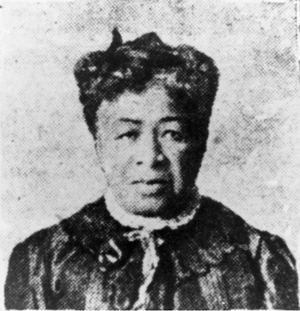Lucy Stanton (abolitionist) facts for kids
Quick facts for kids
Lucy Stanton
|
|
|---|---|

Stanton c. 1910
|
|
| Born | October 16, 1831 Ohio, US
|
| Died | February 18, 1910 (aged 78) |
| Burial place | Angelus-Rosedale Cemetery, Los Angeles, California, US |
| Occupation | Abolitionist |
| Known for | Being the first African-American woman to complete a four-year course of study at a college or university |
| Spouse(s) |
|
Lucy Stanton Day Sessions (born October 16, 1831 – died February 18, 1910) was an important American woman. She was an abolitionist, meaning she worked to end slavery. She also supported women's rights. Lucy Stanton is famous for being the first African-American woman to finish a four-year college program. She completed her studies at Oberlin College in 1850. Her life showed the strength and determination of many women who fought for justice in America.
Early Life of Lucy Stanton
Lucy Stanton was born free on October 16, 1831. She was the only child of Margaret and Samuel Stanton. Her father, Samuel, was a barber. He died when Lucy was only 18 months old.
Later, Lucy's mother married John Brown. He was a well-known abolitionist in Cleveland, Ohio. John Brown was famous for helping enslaved people escape to freedom through the Underground Railroad. Lucy Stanton once said that John Brown would hide as many as 13 runaway slaves in their home at one time.
Lucy Stanton's Education
John Brown believed strongly in education for African-American children. He helped create the Cleveland Free School for them. Lucy Stanton attended this school.
In 1846, Stanton enrolled at Oberlin College. She completed a "Ladies' Literary Course" in 1849. This course was different from the one men took. It did not require foreign languages or advanced math.
While at Oberlin College, Stanton was very active. She joined the Ladies' Literary Society. She was chosen to give a speech at her graduation. The speech was called "A Plea for the Oppressed." In it, she shared her strong feelings against slavery.
Her speech was given just before the Fugitive Slave Act of 1850 became law. This law made it harder for enslaved people to escape. In her speech, Lucy urged everyone, especially women, to imagine being enslaved. She asked them to join the fight against slavery and help end it in the United States. Her speech was very popular. It was printed in school newspapers and other important publications.
Personal Life and Activism
After college, Lucy Stanton became a principal at another free school in Cleveland. On November 25, 1852, she married William H. Day. He was also a graduate of Oberlin College.
Stanton worked as a librarian. She also helped her husband edit Cleveland's first African-American newspaper, The Aliened American. In the first issue, published on April 9, 1853, Stanton became the first African-American woman to publish a story. It was called "Charles and Clara Hays." She was also part of the Chatham Vigilance Committee. This group worked to stop people from being sold back into slavery.
Lucy and William Day had a daughter, Florence Day, born in 1858. After Florence's birth, William Day left for England. Lucy Stanton later divorced him in 1872.
After her husband left, Stanton worked as a seamstress in Cleveland. She continued her activism. She joined the Cleveland Freedmen's Aid Society. This group sent her to teach newly freed slaves. She went to Georgia in 1866 and then to Mississippi.
While in Mississippi, Stanton met Levi Sessions. They married in 1878. The couple moved to Tennessee. There, Stanton kept supporting women's and African Americans' rights. She worked with groups like the Women's Relief Corps, the Order of Eastern Star, the Women's Christian Temperance Union, and the African Methodist Episcopal Church.
After her mother died in 1900, Stanton moved to Los Angeles. In 1904, she helped start the Sojourner Truth Industrial Club. This club was a safe place for the many black working women moving to the city. It aimed to guide and support young African-American women.
Lucy Stanton Day Sessions died in Los Angeles, California, on February 18, 1910. She was 78 years old. She was buried in Angelus-Rosedale Cemetery.

